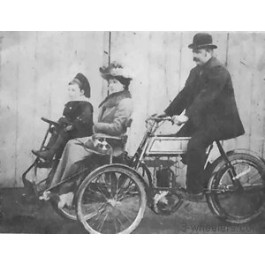The Lion Convertible Motor Cycle was manufactured from 1900 by the Lion Cycle Company, 267 London Road, South Lowestoft, Suffolk. (UK). Head of the company was Mr Thomas Pinnell.
The Lion Convertible model was an upholstered fore carriage on C springs. It also featured a further seat in front for a child of three to six years old, with a dummy steering wheel to keep him - or her - amused. The Convertible included a spare accumulator "giving enough electricity for 700 miles and a petrol tank capacity 100 miles".
Its speed was described as "marvelous" after ascending a good steep hill with two riders, power must be reduced on reaching the level road or the speed will be increased to 30 miles per hour. To transform the single to double use, it is only necessary to detach the single front wheel and put on the two front wheels and fore-carriage which is coupled to the frame with six bolts. When these are secured and the steering connections made good it can be used at once.
The makers gave assurance there is no inconvenience from the position of the 2.75hp De Dion motor between the legs of the rear passenger. The transmission was the more conventional belt drive rather than the earlier all-chain drive via an intermediate countershaft to provide a reduction ratio. One of the vehicles attributes was that “it can be stored in a very small space and will pass through a doorway under three feet wide.”
The Lion Convertible model cost £85 whilst the single bicycle model had a smaller 2.25hp De Dion engine and sold for £45. The non-convertible tandem tricycle cost £75
In 1904 Thomas Pinnell moved to Canada and it is believed that production of the Lion tricycle ceased shortly after. It did however reappear on February 10th 1933 when an advertisement in the Radio Times shows Thomas Pinnell, Anne Maria Pinnell and Cyril Harvey Pinnell
Advertising Mullard valve radios, the photograph has been altered to give Thomas a moustache and glasses. Ann Maria complained to the Radio Times and the advert was withdrawn.




